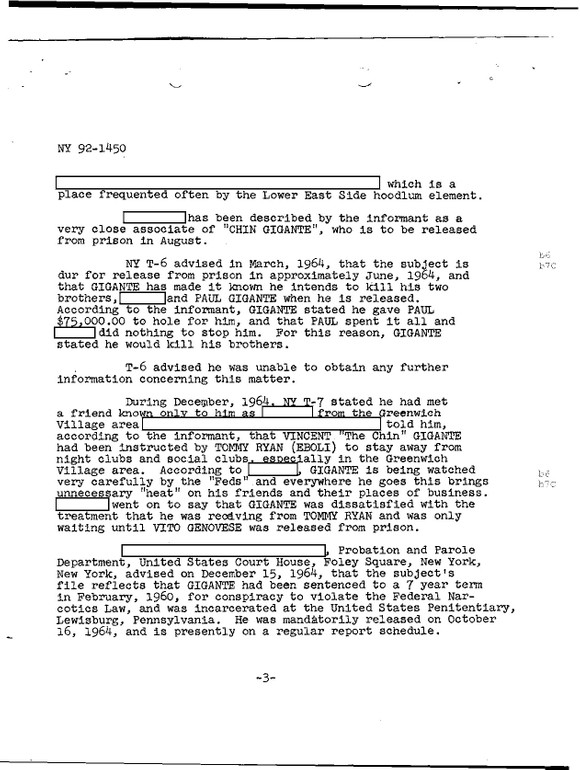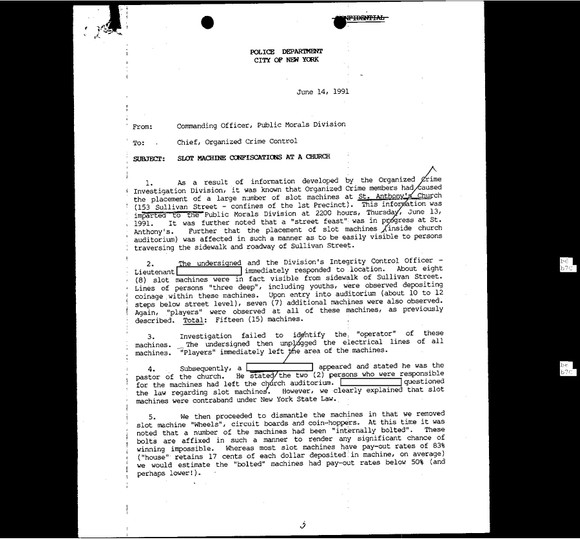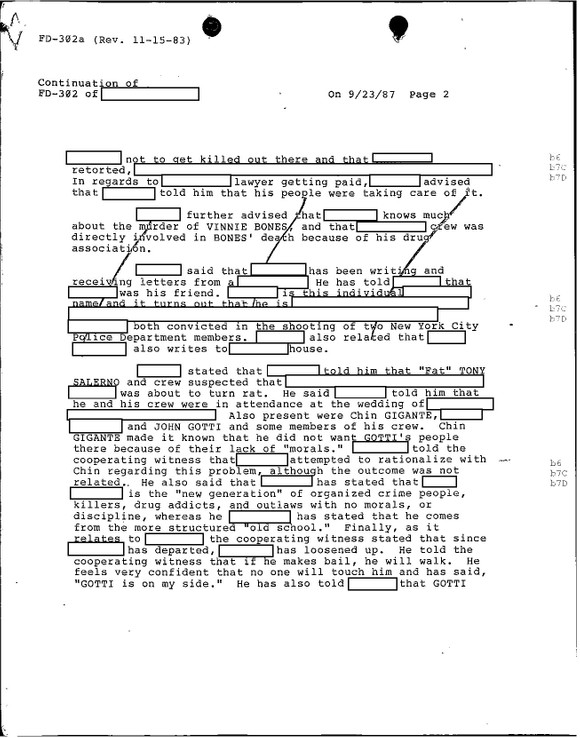Starting from:
$12.95
Vincent "The Chin" Gigante FBI Files and other Related Material - Download
Vincent "The Chin" Gigante FBI Files and other Related Material
3,151 pages of material.
Vincent Louis Gigante (1928 – 2005), also known as "The Chin", was a New York Italian-American organized crime figure, boss of the Genovese crime family. Gigante started out as a professional boxer who fought 25 bouts between 1944 and 1947. He went 21 and 4, with 13 wins by knockout. He then started working as an enforcer for the Luciano crime family, which became the Genovese family. His brothers Mario, Pasquale, and Ralph joined him in crime. His brother Louis became a priest, and later was elected to the city council. By 1981, Vincent was the boss of the Genovese crime family until 2003.
With Lucky Luciano deported to Italy in 1946, Frank Costello became acting boss when underboss Vito Genovese fled to Italy to avoid a murder charge. Costello led the Luciano family until May of 1957. Genovese returned to the United States when a key witness against him was poisoned and the murder he faced charges were dropped.
Genovese took control by sending soldier Vincent “The Chin” Gigante to murder Costello. Costello survived the attack but relinquished control of the family to Genovese, who named the family after himself. Attempted murder charges against Gigante were unsuccessful, because Costello refused to identify him as the shooter. In 1959, it was Genovese’s turn to go to prison following a conviction of conspiracy to violate narcotics laws. He received a 15-year sentence but continued to run the family through his underlings from his prison cell in Atlanta, Georgia.
After sharing a prison cell with Genovese, following Genovese's conviction for heroin trafficking, Gigante became a caporegime, overseeing his own crew of Genovese soldiers and associates who operated out of Greenwich Village. Gigante was one of Genovese's most loyal supporters, siding with him throughout his struggle for power with Costello.
Gigante quickly rose to power during the 1960’s and 1970’s. By 1981 he became the family's boss, while Anthony "Fat Tony" Salerno served as front boss during the first half of the 1980’s. He also ordered the failed murder attempt of Gambino crime family boss John Gotti in 1986. With the arrest and conviction of Gotti and various Gambino family members in 1992, Gigante was recognized as the most powerful crime boss in the United States. For the better part of 30 years, Gigante feigned insanity in an effort to throw law enforcement off his trail. Dubbed "The Oddfather" by the press, Gigante often wandered the streets of Greenwich Village in his bathrobe and slippers, mumbling incoherently to himself.
He was indicted on federal racketeering charges in 1990 but was determined to be declared mentally unfit to stand trial. In 1997 he was declared competent and was tried and convicted on the racketeering charges and was given a 12-year sentence. Facing new charges in 2003, he pleaded guilty and admitted that his supposed insanity was an elaborate effort to avoid prosecution. He died while incarcerated in 2005.
FBI FILES
1,702 pages on FBI Files on Vincent "The Chin" Gigante, boss of the Genovese crime family (1981-2003)
Scope and Content
The files date from 1957 to 2000. They cover a wide range of information gathered on Gigante during his rise in the American La Cosa Nostra. The files show that at least nine individuals close to Gigante were FBI informantsm referred to in the files as T1, T2, T3..., regularly providing information to the FBI. They provided much information about various hits and what was going on in Triangle Social Club at 208 Sullivan St, New York City.
Costello Murder Attempt
On May 2, 1957, Vito Genovese ordered Gigante to murder Luciano family boss Frank Costello, a close friend and successor of Lucky Luciano, the best-known underworld figure in the United States. Gigante shot Costello as he entered the lobby at 115 Central Park West, where he had an apartment in The Majestic, on the corner of 72nd Street, Manhattan. Just as Gigante fired his .38-caliber handgun, Costello moved, causing the bullet to graze the right side of his head. It is believed that because Costello fell down, Gigante thought the mob boss was dead and sped away in a black Cadillac. Costello refused to identify his attempted assassin, leading Gigante to thank Costello in court, but the doorman at 115 Central Park West did. When tried for the shooting, his defense team effectively challenged the credibility of the doorman, and Gigante was acquitted in 1958 on charges of attempted murder An FBI informant characterized the hit as just a warning to Costello.
As Caporegime
A caporegime (usually shortened to a capo) is a rank of a made member of the crime family who heads a "crew" of soldiers and has major social status and influence in the organization.
In 1959, Gigante was convicted, with Vito Genovese, of heroin trafficking and sentenced to seven years in prison. The sentencing judge was swayed by a flood of letters from residents of Greenwich Village and Little Italy attesting to Gigante's good character and his work on behalf of juveniles. He was paroled after five years. Not long afterward, he was promoted from soldier to captain, running the Greenwich Crew. Gigante's crew was based at the Triangle Social Club at 208 Sullivan Street, and also met at the Dante Social Club at 81 MacDougal Street, and the Panel Social Club at 208 Thompson Street. Gigante also met with gangsters and business associates at his mother's apartment. He was involved in bookmaking, loansharking, was immersed in labor racketeering in New York City's construction, waterfront, garbage haulage industries and was identified in the files as being in complete control of fireworks sales and street festivals in New York City.
The crew controlled much of organized crime throughout downtown Manhattan, and Gigante went on to become one of the most powerful caporegimes in New York from the early 1970’s until his promotion to boss in 1981. Some of the rackets included labor union control, gambling, loan sharking, hijackings, and extortion of businesses. Through his brother Mario, who later became a capo of his own crew, the Gigantes maintained influence in the Bronx, Yonkers and upper Westchester. Gigante's closest associates according to the files included his brother Ralph Gigante and Mario Gigante, sons Andrew Gigante and Vincent Esposito, Dominick Alongi, Venero Mangano, Frank Condo, Dominick DiQuarto, Thomas D'Antonio, Frank Caggiano, Louis Manna, Giuseppe Dellacroce, Dominick Canterino, Dominick Cirillo, Joseph Denti, and Joseph Sarcinella.
ADDITIONAL MATERIALS
Additional materials include:
Congressional Report Organized Crime: 25 Years After Valachi: Hearings Before The Permanent Subcommittee On Investigations (1990)
A remarkable 1,260-page report of a congressional hearing, detailing the state of North East U.S. organized crime in 1988. Includes transcripts of live witness testimony including William S. Sessions, Director, Federal Bureau of Investigation. Tommaso Buscetta, former member, Porto Nuova Sicilian Mafia Family, Palermo, Sicily. Angelo Lonardo, former underboss of Cleveland's La Cosa Nostra Family. Vincent "Fish" Cafaro a mobster and protegee of Anthony "Fat Tony" Salerno, a top lieutenant in the Genovese crime family until becoming a government informant and witness, a written statement by Angelo Lonardo, a mobster who became the acting boss of Cleveland crime family in the early 1980’s.
Also includes charts, copies of documents, letters, and written testimony. A chronology of major organized crime events from 1890 to 1987, 3 transcripts of FBI bugged conversations.
State of New Jersey Commission of Investigation The Changing Face of Organized Crime A Status Report In New Jersey May 2004
"Organized crime is alive in New Jersey, if not altogether well," is the opening sentence in this 164-page 2004 report by the State of New Jersey Commission of Investigation







1 file (218.7MB)



